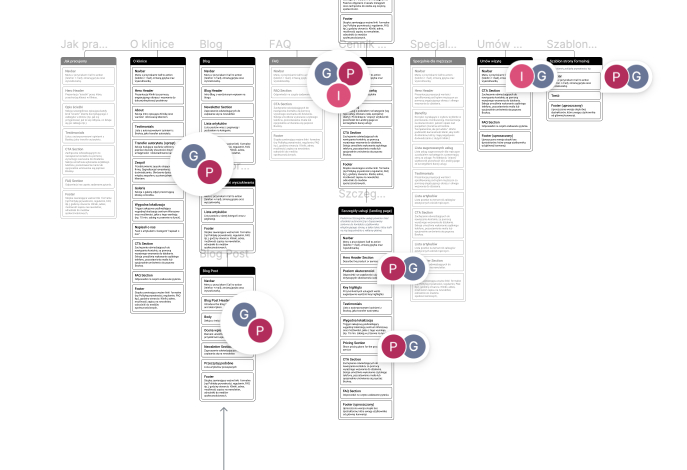In today’s digital world, where information is the key to success, information architecture for a website is an indispensable part of UX design. It is the art of organising and structuring content in a way that makes it easy for users to find the information they need and perform the desired action.
The importance of information architecture in the context of websites
Information Architecture Architecture plays a key role in creating effective and user-friendly websites. Well-designed AI can significantly impact the user experience, increasing user satisfaction, improving conversions and building brand loyalty. In an era where user attention is at a premium, the right information structure can be a competitive advantage for your online business.
What is information architecture for a website?
Information architecture deals with organising, structuring and labelling content in an efficient and understandable way. In the context of websites, AI includes the design of navigation, categorisation and search systems that help users easily find their way through the maze of information and use the site effectively.
Key elements of information architecture include:
- Organisational systems – the way content is grouped and categorised.
- Labelling systems – naming categories and functions in a way that users can understand.
- Navigation systems – methods of navigating around the site and between its sections.
- Search systems – tools that allow users to find specific information.

The role of information architecture in UX and UI
Information architecture provides the foundation for user experience (UX) and user interface (UI) design. The main functions of information architecture include organising content, creating intuitive navigation, improving information retrieval and improving site accessibility. It influences:
- Usability – makes it easy for users to achieve their goals on the site.
- Accessibility – ensures that information is easily accessible to all users, including those with disabilities.
- Intuitiveness – makes navigating the site natural and effortless.
- Efficiency – allows users to find the information they need quickly, saving them time and frustration.
A well-designed information architecture creates a solid foundation for a visually appealing and functional interface, resulting in a positive user experience and the achievement of business goals. For more information on the role of information architecture, see this Norman Nielsen Group article.
Organisation and categorisation of content
One of the primary tasks of information architecture is to logically organise and categorise content on a website. This makes it easier for users to understand the structure of the site and groups information in an intuitive and meaningful way.
Benefits of well-structured content:
- Improved clarity of website content
- Improved user experience
- Better orientation in the service structure
Creating intuitive navigation
Well-designed AI enables an intuitive navigation system. Effective navigation allows users to navigate the site quickly and easily, which significantly impacts their experience and satisfaction with the site.
Improving information search
Information architecture plays a key role in optimising the search process. By implementing efficient search systems and creating logical links between different content elements, AI makes it easier for users to quickly access the information they need.
Elements to improve search:
- Advanced filters and sorting options
- Search suggestions and autocomplete
- Presentation of related content
Improving site accessibility
AI contributes to the accessibility of the website, which is particularly important for people with different types of disabilities. Clear content structure and consistent naming make it easier for all users to navigate and understand the content of the website.

Benefits of using information architecture in web design
The implementation of a well-designed information architecture brings many benefits for both users and website owners.
Improving usability and user satisfaction
Well-designed AI significantly increases the usability level of a website, which directly translates into higher user satisfaction. Satisfied users spend more time on the site and are more likely to return to it in the future.
Improving conversion and engagement
Effective information architecture can lead to higher conversion rates and greater user engagement. Easier access to key content and features makes users more likely to take the desired action on the site.
Examples of improved conversion:
- Increase in online shop sales
- Increase in the number of completed contact forms
- More downloads of information material
SEO optimisation
AI has a positive impact on search engine optimisation (SEO). A logical structure of URLs, facilitated indexing of content by search engine bots and improved internal linking all contribute to strengthening a page’s position in search results.
Reduction in maintenance and update costs
A well-designed information architecture allows content to be more easily managed and updated. This, in turn, leads to a reduction in the costs associated with rebuilding the site in the future and a more efficient use of resources when expanding the site.
Scalability and flexibility of site structure
Robust AI ensures that the site can be easily extended to include new sections and functionality. This allows the site structure to adapt to changing business needs and user expectations, maintaining long-term usability and relevance.
Benefits of a scalable structure:
- Easily expandable with new sections and functions
- Flexible adaptation to changing business needs
- Long-term usability without the need for a complete overhaul
How to implement information architecture in web design?
Implementing an effective information architecture requires a systematic approach and consideration of many factors. Here are the key steps in the process:
Analysis of user needs and business objectives
The first step is to have an in-depth understanding of the users’ needs and the site’s business objectives. This requires:
- User research (e.g. interviews, surveys)
- Analysis of data about user behaviour on the existing website
- Definition of key performance indicators (KPIs) for the project
Creation of site maps and organisation charts
Based on the information gathered, create visual representations of the site structure:
- Site map showing hierarchy and links between sections
- Organisation charts showing grouping and categorisation of content
- Diagrams of user flow through the site
Summary
Information architecture is a fundamental element of designing effective websites. Its importance stems from several key aspects:
- Usability – well-designed AI significantly improves the user experience, making it easier for users to navigate and find the information they need.
- Business efficiency – by improving conversions, user engagement and SEO optimisation, AI directly contributes to business goals.
- Long-term value – a scalable and flexible structure allows for easy adaptation to changing needs, resulting in long-term site usability.
Developing a well-designed information architecture requires a systematic approach, from analysing user needs, to designing the structure and navigation, to continuous testing and refinement. Investing in a well-designed information architecture is a key step in creating an effective online presence for your business. It translates into a better user experience, higher conversion rates and a stronger position in the competitive digital environment.






